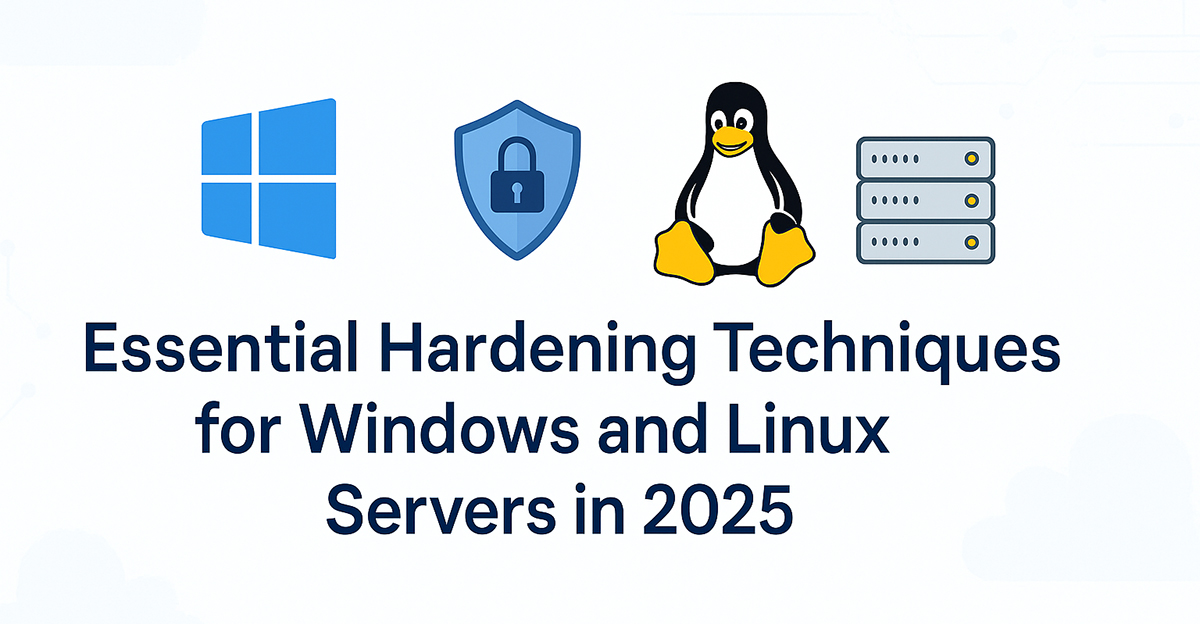No products in the cart.
 2025 Security Guide: Hardening Linux & Windows Servers
2025 Security Guide: Hardening Linux & Windows Servers
In 2025, server hardening has become more critical than ever. With advanced cyber threats targeting Linux servers and Windows servers across on-premises infrastructure and cloud computing environments, securing your digital assets is not optional it’s a necessity. Organizations must implement comprehensive server hardening security measures that align with the latest cybersecurity standards and compliance frameworks.
2025 Server Security: Proactive Defense with Policy-Based Hardening
Modern server hardening transcends basic configurations. It involves continuous auditing, configuration management, software control, secure user access, and advanced threat detection. Linux server security best practices and Windows server protection strategies must integrate with globally accepted policies such as CIS Benchmarks, NIST SP 800-53, ISO/IEC 27001, SOC 2, GDPR, HIPAA, and Zero Trust Architecture. In 2025, server security means staying ahead of attackers-not just responding to breaches.
Key 2025 Security Measures Every Organization Must Enforce:
Zero Trust Network Architecture:
Implement a “never trust, always verify” model to ensure continuous authentication and strict access control.
Multi-Factor Authentication (MFA):
Deploy MFA across all administrative and remote login points. Secure Linux SSH access and Windows RDP sessions with MFA tokens or biometric identification.
OS and Kernel Patch Management:
Regularly update the Linux kernel, Windows OS, and all packages. Use automated patching tools that offer rollback in case of failures. Schedule weekly scans for unpatched vulnerabilities.
Role-Based Access Control (RBAC):
Enforce strict least privilege principles by assigning users only the access necessary for their roles. Define access roles clearly, enforce job-based restrictions, and disable dormant or terminated user accounts regularly.
Security Information and Event Management (SIEM):
Utilize modern SIEM platforms for live log monitoring, anomaly detection, and incident alerting. Store logs in immutable storage for regulatory compliance.
Endpoint Detection and Response (EDR):
Install EDR agents on every server instance to enable continuous threat detection and automated responses to suspicious behaviors.
Firewall Hardening and Intrusion Detection Systems (IDS):
Restrict open ports to only essential services. Combine Next-Gen Firewalls (NGFW) with IDS/IPS solutions to proactively detect malicious traffic.
Encrypted Communications:
Ensure that TLS 1.3 is uniformly adopted for securing all network traffic. Disable legacy protocols such as SSLv3 and TLS 1.0/1.1. Replace password logins with SSH keys for all Linux remote sessions.
File Integrity Monitoring (FIM):
Deploy FIM tools to track changes in critical system files, configurations, and binaries. Integrate alerts with SIEM for proactive threat investigation.
Secure Boot and BIOS Lockdown:
Activate UEFI Secure Boot, disable unused boot devices, and set strong BIOS/UEFI passwords to prevent physical or firmware-level attacks.
Container and VM Security:
Use container runtime security, image scanning, namespace isolation, and least privilege access in Kubernetes and Docker workloads. Secure virtual machines with hypervisor hardening.
Vulnerability Scanning and Penetration Testing: Conduct weekly vulnerability scans and biannual penetration testing to identify and fix security weaknesses. Prioritize remediation based on CVSS severity.
Disaster Recovery and Encrypted Backup Solutions:
Deploy versioned, offsite, and encrypted backup strategies. Test disaster recovery processes quarterly to ensure minimal downtime during cyber events.
Compliance Monitoring and Audit Automation:
Leverage tools such as OpenSCAP, Chef InSpec, and Aqua Security to enable real-time tracking and enforcement of compliance standards. Streamline compliance efforts through automated reporting for SOC 2, HIPAA, PCI-DSS, and GDPR audits.
Threat Intelligence Integration:
Subscribe to live threat intelligence feeds, update blocklists, and proactively identify TTPs (Tactics, Techniques, Procedures) of adversaries using tools like MISP, AlienVault OTX, and MITRE ATT&CK.
Mitigating Risk with 2025-Ready Server Hardening Strategies
By aligning your systems with these 2025-ready server hardening strategies, businesses dramatically reduce the chances of data loss, system compromise, and regulatory fines.
Secure, Optimize, and Comply: 24/7 Server Management by actsupport.com
If your organization seeks expert-driven, proactive, and 24/7 secure infrastructure management, partner with actsupport.com your dedicated provider for Linux server hardening, Windows server management, cloud infrastructure protection, and managed cybersecurity services. Our experienced engineers and certified security professionals ensure that your systems meet evolving standards while maximizing performance, uptime, and compliance.
[/vc_column_text]
Check out our newest blog entry (DNS Demystified: How Domain Name System Powers the Web)



 2025 Security Guide: Hardening Linux & Windows Servers
2025 Security Guide: Hardening Linux & Windows Servers